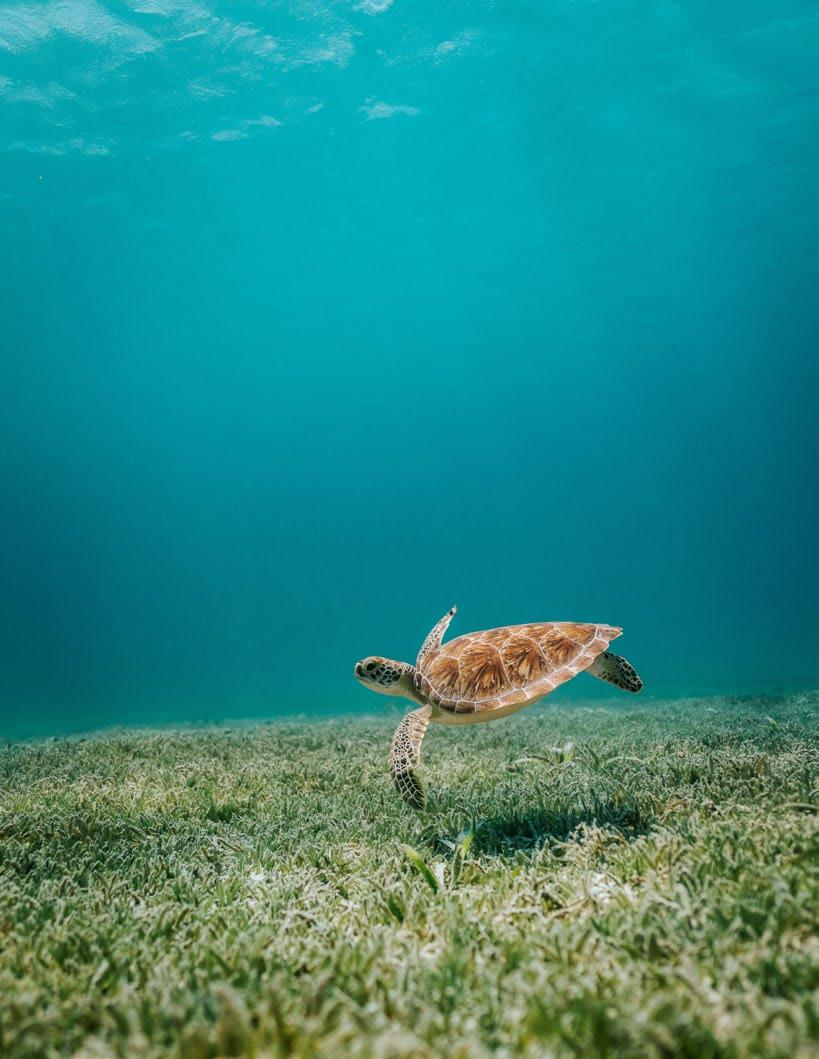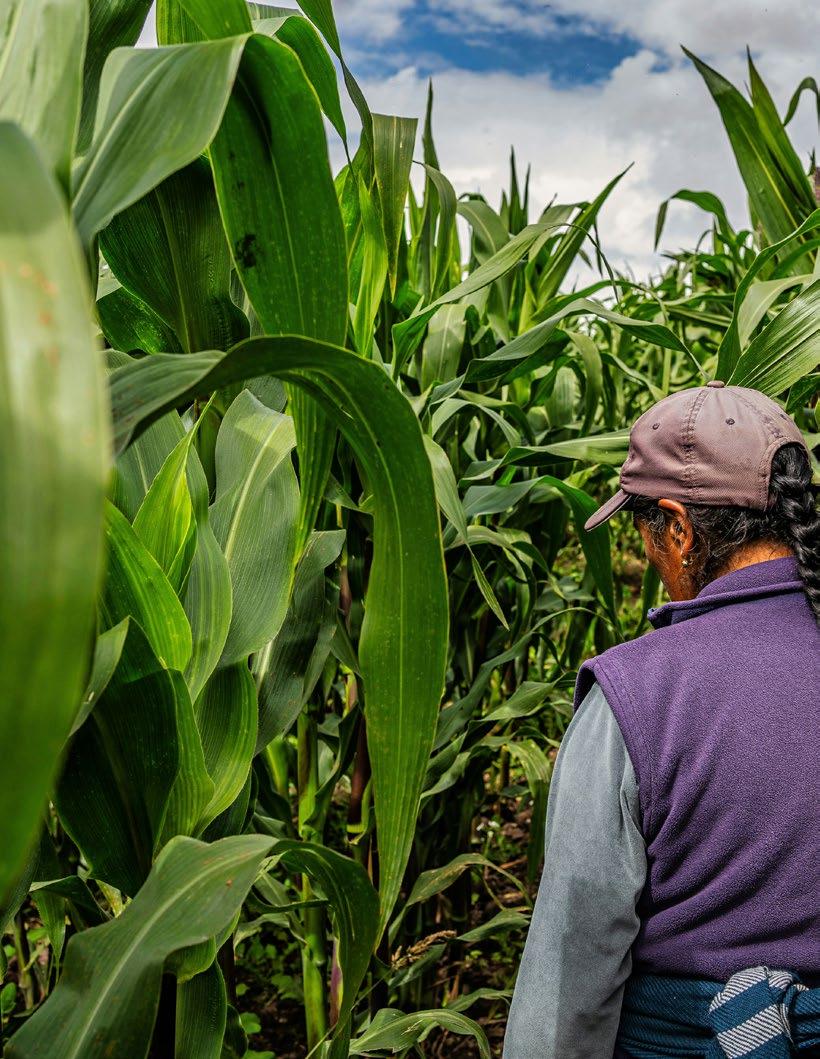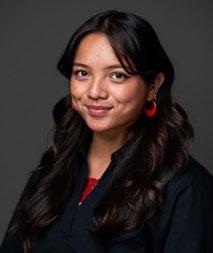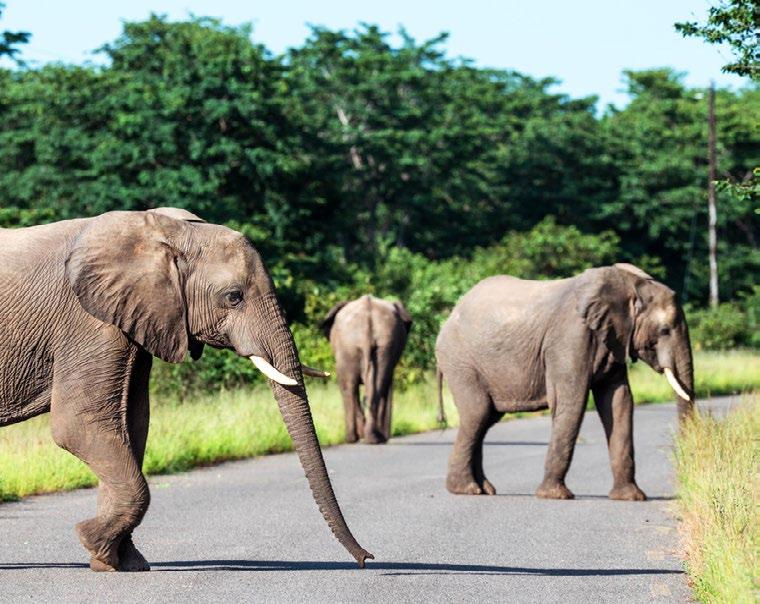

Tackling Our Climate Crisis
UC Santa Barbara-Conservation International Arnhold Climate Solutions Collaborative 2024 – 2025
Annual Report Prepared for John Arnhold
Letter to John Arnold
Mr. John P. Arnhold Arnhold Family Foundation
Dear John,
The world is in a race against time to prevent catastrophic climate change. Nature has the power to help – but we must work at extraordinary speed and scale to protect, manage, and restore nature’s ability to do so. The Arnhold UC Santa Barbara-Conservation International Climate Solutions Collaborative (Arnhold CSC) is rising to this challenge, thanks to your sustained commitment to advancing research that drives real solutions.
Following the successful first cycle of projects, Arnhold CSC has shown what is possible when cutting-edge research meets real-world action. With this foundation of global impact, we embarked on a new three-year cycle in 2024 (henceforth referred to as “CSC 2.0”) which carries forward past successes with even greater ambition and reach. This next phase of our partnership demonstrates your conviction that empowering students and building connections across organizations are critical to tackling the challenges of climate change.
The first year of CSC 2.0 is off to a strong start, grounded in the relationships, field connections, and lessons from our initial three years of projects. More than ever before, we see UCSB researchers, Arnhold Fellows, and CI scientists working together as a collaborative team to develop forward-thinking solutions to protect our environment, human health, and community well-being.
This report reflects the research progress, early wins, and anticipated impact of CSC 2.0. The Arnhold Environmental Fellows program trains students on cutting-edge climate solutions and allows research teams to delve deeper into conservation management design. Turning research into action, we are providing in-country teams and partners with innovative and applicable climate solution tools and frameworks. Below are some of the partnership highlights from CSC 2.0’s first year:
• Four national governments in Latin America committed to protecting highly migratory marine megafauna species (whales, dolphins, sharks, rays, and turtles).
• Landmark Science publication confirmed that most fully protected marine protected areas are effective, with satellite and AI data showing little-to-no industrial fishing in these areas.
• Student-led study modeled trade-offs of recultivating versus rewilding abandoned fields, showing that strategic land-use planning can reduce habitat fragmentation by 17%, enhance carbon storage, and improve species connectivity.
• 150 stakeholders from nine countries convened for Herding4Health Indaba (Zulu word for important discussion) and follow-up workshops, producing four co-designed research tracks and pilot sites for rangeland restoration.
• 30 Arnhold Fellows trained in climate and conservation science, producing 10 technical species briefs, contributing to multiple peer-reviewed publications, and conducting technical analyses and building tools that shape on-the-ground conservation.
As you read through this report, we hope you see your impact reflected in every achievement. Your generous support is an inspiration on how contributions to collaborative science can lead to impactful and actionable solutions for the global climate crisis. UCSB and CI are so grateful for your continued partnership for this important work.
Sincerely,

Dr. Steve Gaines Dean, Bren School of Environmental Science and Management, University of California, Santa Barbara

Dr. Stephanie Wear
Senior Vice President, Betty and Gordon Moore Center for Science and Solutions, Conservation International
Background
In the first cycle of projects, the UC Santa Barbara–Conservation International Arnhold Climate Solutions Collaborative successfully advanced solutions across 16+ countries, launched six major projects, published more than 30 papers, created 19 practical tools, and engaged over 50 students. By combining expertise across fields like environmental science, computer science, economics, and policy, we showed how interdisciplinary collaboration can generate insights and tools to navigate the complex challenges of climate change.
In shaping CSC 2.0, we sought to highlight the unique strength of uniting two powerful organizations. Together, UC Santa Barbara and Conservation International (CI) bring the expertise and resources needed to drive impact-driven research while accelerating the pipeline from innovation to on-the-ground implementation. We placed renewed emphasis on supporting UCSB’s engagement of diverse students through the Arnhold Environmental Fellowship, while ensuring CI’s field teams continue to bring research findings directly into practice on the ground.
This new phase of our partnership is anchored by two key themes: Scaling Natural Climate Solutions and Bolstering Ocean Conservation and Resilience. Within each theme, two high-impact projects were selected for their ability to address urgent real-world needs and leverage the unique strengths of UCSB and CI to move solutions into action more rapidly. Together, these projects span a breadth of work to advance foundational research, create practical tools and frameworks, inform governance, shape policy, and ultimately drive meaningful change for communities and ecosystems across the globe.




The Partnership by the Numbers
4
Projects launched under CSC 2.0.
5
Convenings held, engaging 200+ stakeholders.
30
Arnhold Environmental Fellows supported this year.
4
National government commitments.


37+
Research outputs developed or in progress: 10 technical species briefs completed, 7 papers published, and 20+ manuscripts/ reports in development.
17+
Countries engaged in our work: Bolivia, Brazil, Chile, Colombia, Costa Rica, Ecuador, Fiji, Gabon, South Africa, India, Mexico, Namibia, Niger, Pakistan, Peru, Canada, and the EU.
Arnhold Environmental Fellows
Tackling our climate crisis
The Arnhold Environmental Fellows program has been integral to CI and UC Santa Barbara’s successful collaboration and research impacts and has supported 80 students to date. This year, we brought on 30 students to work across two innovative research themes–Scaling Natural Climate Solutions and Bolstering Ocean Conservation and Resilience–that benefit the environments where we work.
In the Eastern Tropical Pacific, Fellows authored 10 technical briefs on whales, dolphins, sharks, rays, and turtles that will inform regional climate vulnerability assessments, while others developed species distribution models and bycatchreduction tools in collaboration with the Inter-American Tropical Tuna Commission.
Across Africa, Fellows advanced spatial planning research by modeling human–elephant conflict and connectivity in the Kavango–Zambezi Transfrontier Conservation Area. Their analyses are supporting land-use decisions in one of Africa’s most critical corridors and leading to peer-reviewed publications.
Specific to Southern Africa, Fellows supported the Herding4Health initiative by conducting a review of rangeland health assessment methods and helping to establish four pilot landscapes for impact evaluation. These efforts are shaping how community well-being and ecological restoration are measured on the ground.
Together, Arnhold Fellows are not only producing publications, briefs, and analytical tools that shape global conservation practice, but also gaining the research, technical, and interdisciplinary collaboration skills needed to become the next generation of environmental leaders.






























Meet the 30 students supported this year by the Arnhold Environmental Fellows program.


Research Theme Bolstering Ocean Conservation and Resilience
The ocean is changing faster than any other ecosystem on Earth. Rising temperatures, acidification, and shifting currents threaten marine life and the communities that depend on it. Building resilience in our oceans is critical for the planet’s future.

Research Project
Conservation of Highly Migratory Species with Climate Change
Project team
Dr. Lee Hannah (CI), Dr. Emily Pidgeon (CI), Dr. Steve Gaines (UCSB), Dr. Marco Quesada (CI), Dr. Jennifer L. Raynor (Wisconsin), Dr. Chris Costello (UCSB), Dr. Isaac Brito-Morales (CI), Jennifer Bone (UCSB), and Dylan Glave (CI)
UCSB Arnhold Fellows
Kinsey Matthews, Sadie Cwikiel, Shu Chen Tsao, Mukta Kelkar, Sarayu Ramnath, Lenaya Aiden-Gonzales, Hayden Vega, and Justin Kim
Project Description
Marine megafauna such as whales, dolphins, sharks, rays, and sea turtles are both charismatic and ecologically critical, yet their wide-ranging migrations make them especially vulnerable to human pressures and climate change. Working primarily in the Eastern Pacific, this project aims to safeguard these species by modeling how migrations may shift as oceans warm and partnering with governments to design climatesmart protection measures.
Impact to Date
Research and Publications
• Lenaya Gonzales and Sarayu Ramnath authored ten technical briefs on the life histories of marine megafauna, climate vulnerability, and ecological roles. This will inform the Climate Change Assessment and will be delivered to federal policy-makers in Latin America.
• Shu Chen Tsao explored how payment-for-ecosystem service programs, common on land, could be adapted to support marine megafauna conservation in the Eastern Tropical Pacific.
• Kinsey Matthews and Sadie Cwikiel conducted a comprehensive review of species habitat associations and ecological modeling and initiated collaborative SDM work with the Inter-American Tropical Tuna Commission. Not only are they developing a decision-support tool to provide fishers with near real-time guidance, this research will be ultimately published in peer-reviewed journals and incorporated into their dissertation chapters.
• Mukta Kelkar examined how marine protected areas enhance resilience to climate change, identifying gaps in current research. A forthcoming publication will share her findings. She is also using NOAA data to assess the extent to which marine protected area design features correlate with ecosystem resilience in the United States.
• Yutian Fang reviewed 500 studies on temporary marine closures, demonstrating their potential to deliver short-term fishery benefits and build community support for longer-term protections.
• Leonardo Feitosa, Hayden Vega, and Justin Kim investigated drivers of luxury seafood markets, often linked to marine megafauna, and identified countries in the Eastern Tropical Pacific where these fisheries may expand.
Policy and Management
• Four national governments (Costa Rica, Ecuador, Peru, Colombia) have agreed on a list of 10 highly migratory species from the “Blue 5”— whales, dolphins, sharks, rays, and sea turtles— for analysis, monitoring, and climate-smart protection.
• CI scientists and Arnhold Fellows will deliver a Climate Change Assessment on the 10 Highly Migratory Species to CI country programs and government officials throughout Latin America.
Data and Tools
• High-resolution regional ocean model (100x finer than global models) under development following a June 2025 workshop in France. The model will project climate-driven changes in the Eastern Tropical Pacific.
• Species Distribution Models for sharks/rays, marine mammals, and sea turtles under development. It is informed by expert input gathered at a Panama workshop with participants from eight countries.
Partnerships, Outreach, and Capacity Building
• Four government partners engaged in Southern and Central America: Costa Rica, Ecuador, Peru, and Colombia.
• Two international workshops convened, strengthening scientific and policy collaboration in the Eastern Tropical Pacific.
• Reached 60+ participants at the Panama City Encuentro Del Pacifico Sudeste (November 2024)
• $3M GEF grant secured to support data-sharing, capacity building, and megafauna monitoring.
Looking Ahead
In the coming year, the team will deepen collaboration with government and science stakeholders to address growing threats to marine megafauna from climate change and human pressures in the Pacific.
Key priorities include:
• Delivering a Climate Change Assessment on the 10 focal species to CI country programs and government officials.
• Producing Regional Ocean Models and Species Distribution Models to project how species may shift under different climate scenarios
• Advancing research on the “Blue 5” (whales, dolphins, sharks, rays, and sea turtles), including innovative policy designs, the impacts of climate change on the “Blue 5,” and decision-support tools to strengthen on-the-ground conservation.
• Connecting our science to implementation with a large policy and monitoring program led by GIZ, connected through Arnhold scientist Marco Quesada.
Results from this research will inform and advance knowledge of where marine animals will migrate in the Pacific, what threats they may encounter, and how governments can protect them. By connecting science with CI Field Teams and the governments of Costa Rica, Peru, Colombia, and Ecuador, the project ensures that cutting-edge data informs real-world policy and conservation decisions.
Student Perspectives



Sarayu Ramnath
Master of Environmental Science and Management,
2026
“As a graduate fellow on Conservation International’s Save the Blue 5 (SB5) project, I am supporting a climate change vulnerability assessment for marine megafauna in the Eastern Tropical Pacific by researching, writing, and engaging with collaborators to shape a meaningful and actionable report. This experience has solidified my passion for marine conservation and has sparked a new interest in working internationally. Working and learning alongside a dedicated local team while meeting with researchers across time zones has shown me how powerful cross-border partnerships can be in driving regional impact. I’m incredibly grateful for the chance to grow as a scientist while contributing to work that supports climate resilience for marine species and local communities.”
Hayden Vega
B.A. Marine Science, B.S. Environmental Studies, B.S. Ecology and Evolution, 2025
“The Arnhold Climate Collaborative Fellowship is special. It provides an opportunity to learn from a unique community where science is driven not by problems but by solutions—which is especially meaningful during a time when climate action feels like an uphill battle. But, if working with the Arnhold Climate Collaborative has taught me anything, it’s that science can make a difference. And it’s this belief that has inspired me to pursue a career in science and climate solutions.”
Lenaya-Aiden Gonzales
Master of Environmental Science and Management, 2026
“Working with Conservation International as an Arnhold Fellow has opened my eyes to the vast and interconnected world of marine conservation. Coming from a background in terrestrial ecosystems, I am especially grateful for the opportunity to work alongside an inspiring team and engage with researchers from around the world. I never expected to find myself on calls across several time zones, meeting experts, and learning firsthand about their work. As our oceans undergo rapid change, this opportunity has proved to me just how essential regional and international collaboration is for protecting marine life and shaping a more resilient future.”

Research Project
Integrating Protection and Production in Ocean Conservation
Project team
Dr. Jennifer L. Raynor (Wisconsin), Dr. Chris Costello (UCSB), Gavin McDonald (UCSB), Dane Klinger (CI), and Dr. Emily Pidgeon (CI)
UCSB Arnhold Fellows
Xanthe Vitaz and Jahat Garcia
Project Description
With the acceleration of global biodiversity loss and climate change, there is a timely need for ocean protection and sustainable management. This is the science that brings together the ‘twin pillars’ of protection and production in order to effectively achieve global conservation targets.
Impact to Date
Research and Publications
• Published a landmark Science study, “Little-to-no industrial fishing occurs in fully and highly protected marine areas,” showing that marine protected areas (MPAs) safeguard fish and ecosystems, with satellite imagery and AI confirming little to no illegal fishing in most fully and highly protected areas—dispelling concerns about “paper parks.” This is a hopeful finding and a demonstration of how open data and AI can be used to monitor ocean protections at scale.
• Launched new research examining whether fishers sometimes act as voluntary stewards of the ocean even in the absence of formal fisheries management. This could be an example of “informal property rights”, and would upend widely held assumptions about open access natural resource systems. If this turns out to be the case, we plan to quantify these conservation benefits that are voluntarily generated by fishers.
Policy and Management
• Perspective piece published in Science as a direct result from our research findings on industrial fishing effort within highly protected marine areas. The article raises key fisheries management questions and underscores the broader implications for ongoing efforts to expand MPAs globally.
Data and Tools
• Xanthe Vitaz and Jahat Garcia are building a global dataset of implementation and announcement dates for 500+ MPAs, which will be used to evaluate how marine protections influence fishing effort. This dataset will form a foundation for current and future global MPA research.
Partnerships, Outreach, and Capacity Building
• Launched a communication campaign in collaboration with our partners at the University of Wisconsin–Madison, Global Fishing Watch, and National Geographic Pristine Seas around the publication of our milestone Science paper. This effort led to two press releases and widespread media coverage, including features in The Conversation, NPR, The New York Times, and more than two dozen other outlets.
Looking Ahead
In the coming year, the team will advance research to better integrate ocean protection with sustainable production.
Key priorities include:
• Testing the “Blue Paradox” effect across dozens of marine protected areas worldwide. Understanding how much fishers respond to the announcement of new MPAs will help inform whether or not they are already voluntarily conserving their resources.
• Using vessel-level AIS data and our newly developed dataset of 500+ MPAs to analyze changes in fishing behavior after MPA announcements.
• Quantifying the magnitude of previously unrecognized conservation benefits provided by fishers through informal property rights.
Little-to-no Industrial fishing activity occurs in fully and highly protected MPAs. (source)

This research will determine whether fishers voluntarily contribute to conservation and provide new insights into how protection and production can be better integrated.
Maps show global patterns of fishing effort detected inside MPAs. These analyses demonstrate that most fully and highly protected MPAs experience little to no industrial fishing activity.
Student Perspectives


Xanthe Vitaz
B.S. Aquatic Biology, 2025
“As a 2025 Arnhold Undergraduate Fellow, I was given the opportunity to grow my skills in scientific research and data collection, work alongside an incredible team, and explore how various career fields can combine their knowledge to better understand the world/environment. It is rare to find a paid opportunity like this that allows students to grow as researchers and individuals, something that I believe is incredibly important for young scientists navigating their future careers. I am immensely grateful for the skills and experiences my time as an Arnhold fellow has brought me, and I am excited to apply what I have learned in future positions.”
Jahat Garcia
B.S. Environmental Studies, 2026
“Participating in the Arnhold Fellowship this past spring and summer allowed me to immerse myself in the world of research and professional development. Through this project, I gained valuable skills and deepened my understanding of the research process, particularly through my literature review. This experience has made a meaningful impact on my journey at the University of California, Santa Barbara, and has prepared me to confidently pursue the rigorous world of post-graduate research.”


Research Theme Scaling Natural Climate Solutions
Nature holds some of the most powerful answers to climate change. From forests and wetlands to grasslands and mangroves, these ecosystems absorb carbon, protect communities, and sustain biodiversity. Expanding Natural Climate Solutions (NCS) is one of the most urgent opportunities we have today.

Research Project
Spatial Planning for Climate Change, Land Use, Agriculture, and Energy (SPARCLE)
Project team
Dr. Ashley Larsen (UCSB), Patrick Roehrdanz (CI), Joana Krieger (CI), Dr. Evan Patrick (UCSB), Nick McManus (CI), Luke Wilson (CI-South Africa), Dr. Kavya Pradhan (CI), and Dylan Glave (CI)
UCSB Arnhold Fellows
Alyssa Jain, Noah Moyer, Sam Muir, Olivia Somhegyi, Maxwell Pepperdine, Christy Yu, Dana Cohen-Kaplan, Olivia Hemond, and Vikesh Dheeriya
Project Description
To achieve global climate goals and halt biodiversity loss, we need to ensure new conservation areas are climate resilient. SPARCLE develops the science to identify where protection, restoration, and sustainable management are most effective as the climate changes, helping decision-makers plan for a future where conservation, energy, and agriculture must coexist.
Impact to Date
Research and Publications
• Alyssa Jain was the first author in a student-led study, “Assessing future environmental benefits of agricultural abandonment and recultivation,” published in Environmental Research Letters that models the environmental trade-offs of agricultural abandonment versus recultivation under different future socioeconomic scenarios. A blog and a press release were developed.
• Maxwell Pepperdine, Christy Yu, Dana Cohen-Kaplan, Olivia Hemond, and Vikesh Dheeriya modeled human–elephant conflict and landscape connectivity in the Kavango–Zambezi Transfrontier Conservation Area, which will support land-use decisions in one of Africa’s most critical corridors. A peerreviewed manuscript is forthcoming.
• Evan Patrick (Postdoctoral scholar), with Patrick Roehrdanz and Ashley Larsen, modeled ecological lags in species range shifts, challenging assumptions about the speed of climate adaptation.

• Published a peer-reviewed paper titled, “Addressing the urgent climate and biodiversity crisis through strategic ecosystem restoration in Brazil”, in Biological Conservation addressing the urgent climate and biodiversity crisis through strategic ecosystem restoration in Brazil.
• Co-authored a preview titled, “Integrate biodiversity and resilience into climate-driven forest restoration strategies for the Atlantic Forest”, in One Earth highlighting the importance of integrating biodiversity and resilience into climate-driven forest restoration strategies for the Atlantic Forest.
• Co-authored a paper titled, “Afro-descendant lands in South America contribute to biodiversity conservation and climate change mitigation”, in Nature Communications mapping the conservation impact of Afro-descendent peoples’ stewardship in South America.
• Published an additional three additional papers on global drought patterns, tropical butterfly distributions, and other studies that advance environmental science and
Policy and Management
• CI’s NCS Roadmap for Africa was developed with climate and biodiversity insights from the SPARCLE team. This roadmap will guide national and regional planning for conservation and development.
• SPARCLE’s land-use tradeoff analysis was presented to CI leadership, strengthening integration of spatial planning into organizational decision-making.
• Joana Krieger was selected as a Fellow for the Intergovernmental Science-Policy Platform on Biodiversity and Ecosystem Services (IPBES) spatial planning assessment, where she will focus on future planning.
SPARCLE scientists and partners finish a week of presentations at a United Nations Convention to Combat Desertification conference by participating in South Africa’s Presidential ‘Ten Million Trees’ program at a community park in Pretoria, South Africa.
Data and Tools
• Carbon potential analysis delivered to the Africa NCS Roadmap, which identifies land with the highest climate benefits across sub-Saharan Africa.
• Nine land-use allocation maps created for South Africa, one per ecoregion, to inform strategies and investment decisions.
• Tradeoff analyses developed to evaluate biodiversity, carbon storage, and Nature’s Contributions to People (NCPs), supporting balanced land-use decisions.
Partnerships, Outreach, and Capacity Building
• Presented research and tools at three workshops in Nairobi and Johannesburg, engaging African partners and NCS roadmap stakeholders.
• Partnered with Conservation South Africa (CSA) to research the Herding4Health (H4H) program as it scales to seven countries, including the ongoing development of suitability maps to align physical, biological, and social conditions with program objectives.
• Strengthened collaboration with CSA, with SPARCLE’s land-use analyses initiating deeper integration between CSA and SPARCLE.
• Trained Arnhold Fellows and early-career scientists in spatial analysis, ecological modeling, and stakeholder engagement, building the next generation of interdisciplinary conservation leaders.
Looking Ahead
This next year, the SPARCLE team will partner with CI Field Management Units in Africa to design tailor-made maps and analyses for conservation decision-makers.
Key priorities include:
• Convening a workshop of spatial planning experts and local practitioners to map future scenarios for conservation, renewable energy, and agricultural development. Using specialized mapping methods, this group will be focused on answering the question, “What will this landscape look like in 50 years, and where should we plan conservation, renewable energy, and agricultural development to suit this evolving landscape?”
• Providing science-backed tools to CI partners and policymakers so that national and regional governments can make informed decisions balancing biodiversity, carbon, and human needs.
By connecting cutting-edge science with CI field teams, governments, and partners across Africa, SPARCLE will help countries pursue biodiversity, carbon, and community goals together—shaping landscapes that can thrive for the next 50 years and beyond.
Student Perspectives


Maxwell Pepperdine Master of Environmental Science and Management, 2025
“Working as an Arnhold Fellow over the past year has been an incredibly rewarding experience. I’ve had the opportunity to contribute to impactful research, expand my technical and professional skills, and build connections with fellow researchers and advisors from whom I’ve learned so much.”
Vikesh Dheeriya B.S. Hydrologic Science and Policy, 2026
“Over the past year as an Arnhold Fellow, I’ve gained crucial skills in coding, ecological modeling, remote sensing, and literature synthesis. Experiencing the full research process, including the highs and lows, while collaborating with faculty, conservation experts, and graduate students has been the most valuable part of my undergraduate education. The flexibility given by my advisors to explore and pursue my interests within an established research project has strengthened my voice and confidence, which I will take with me the rest of my career.”

Research Project
Innovations in Impact Evaluation to Design and Scale Natural Climate Solutions
Project team
Dr. Rober Heilmayr (UCSB), Dr. Kathy Baylis (UCSB), Dr. Seb Costedoat (CI), Thulani Ningi (CI), Dr. Flavio Malagutti (UCSB), Heather Lahr (UCSB), and Dylan Glave (CI)
UCSB Arnhold Fellows
Gemma de Rossi, Ethan Castelazo, and Zachary Scholnick
Project Description
This project is a multi-sector partnership between UCSB, Conservation International (CI), Conservation South Africa (CSA), and Meat Naturally to co-design rigorous impact evaluations of the Herding4Health (H4H) model. H4H is a community-based rangeland restoration initiative that CI, Meat Naturally, and Peace Parks Foundation are scaling across more than seven countries in Southern and Eastern Africa. By co-designing our research agenda with local partners, the project ensures that impact evaluations generate the empirical evidence needed to guide Natural Climate Solutions policy and practice.
Impact to Date
Research and Publications
• Identified pilot landscapes in South Africa for initial rangeland restoration research.
• Engaged 60 technical, implementing, and research partners in a three-day workshop (March 2025) to define priority research questions for scaling H4H.
• Co-designed four research tracks with partners to measure community well-being, restoration outcomes, incentive effectiveness, and cost-effective monitoring.
• Ethan Castelazo and Zachary Scholnick led a literature review on methods for assessing rangeland health, covering both remote sensing and traditional field approaches.
• Report summarizing CI case studies of Conservation Stewardship agreements, including H4H in Namaqualand, South Africa, slated for publication at the end of 2025.
Policy and Management
• Research design aligned with Conservation South Africa, Meat Naturally, and other partners to ensure evaluations directly inform real-world implementation of rotational grazing strategies.
Data and Tools
• Data Use Agreement signed with Meat Naturally to enable access for field deployment in two pilot communities.
• Cognitive Mapping protocol designed to identify community-defined well-being priorities. With support from Meat Naturally, the team will pilot the protocol in two communities in mid-2025.
Partnerships, Outreach, and Capacity Building

• 150 participants—including tribal leaders, policymakers from nine African countries, and technical specialists—attended the H4H Community of Practice Indaba or meeting (January 2025), a conference in Zulu and Xhosa languages, where Dr. Sebastien Costedoat led a session on principles for experimentally evaluating innovative H4H incentives.
• Convened two workshops in Cape Town and Pietermaritzburg (March 2025) with CSA research leads, Meat Naturally staff, and partner leadership to co-design research priorities and align implementation strategies.
Meat Naturally leadership celebrates a successful three days of research design and collaboration building with our CI and UCSB teammates in Pietermaritzburg, South Africa.
Looking Ahead
In the coming year, project researchers will initiate research across the four identified research tracks, continuing a partnership with local communities, pastoralists, and stakeholder partners.
Key priorities include:
• Piloting the well-being analysis in two communities, with expansion to 20 partner sites, training Meat Naturally field officers in participatory data collection.
• Delivering results of the restoration quasi-experiment.
• Convening with Meat Naturally to review findings, define next steps for measuring the impact of rotational grazing, and refine participatory research approaches.
• Advancing behavioral game–based methods to design and test benefit-sharing agreements, building the foundation for future field-based research.
This research will inform the design of a full Randomized Controlled Trial to rigorously evaluate H4H’s ecological and social outcomes. By strengthening partnerships with local communities and implementation teams, the project will help scale nature-smart grazing systems that benefit both people and ecosystems across Southern Africa.
Student Perspectives

Gemma Di Rossi Ph.D. Student, Bren School of Environmental Science and Management
“After the new federal government policies slashed my planned Ph.D. funding and research, I was invited onto the Arnhold project to help conduct an impact evaluation on Meat Naturally’s ability to achieve grassland restoration goals using a rigorous empirical design known as a quasi-natural experiment. This project fits deeply with my Ph.D. mission to understand the impact of payment for ecosystem services schemes at the intersection of the natural environment and agricultural systems, and the potential to create win-win solutions for economic livelihoods and environmental restoration. I’ve also had the wonderful opportunity to mentor and work with talented undergraduate students as research assistants this summer; introducing them to the research process and seeing their technical skills improve has been an extremely rewarding experience, and I hope to continue as a role model to encourage more young people to engage in impact-oriented research.”
Thank You!
Thank you for your generous support. All of us at UC Santa Barbara and CI are immensely grateful for the opportunity to deliver highquality research and publications that inform the next generation of conservation work, while building critical partnerships that empower early-career professionals and scientists. Together, we are achieving significant progress toward working as a global community to tackle the climate crisis and build a more resilient planet for current and future generations.


